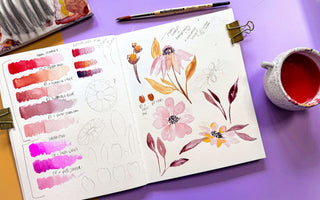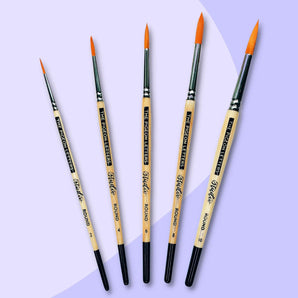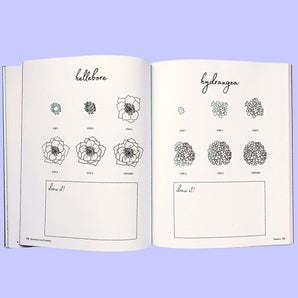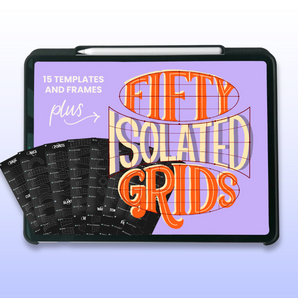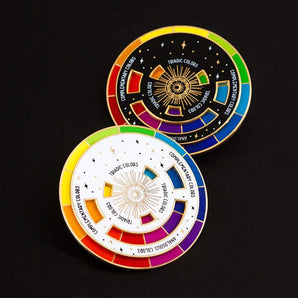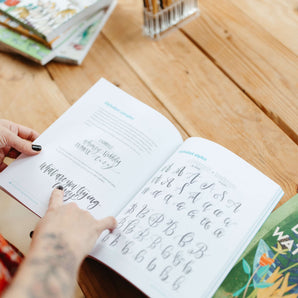Stuck with boring lettering? Adding interesting effects can make a big difference to how your lettering looks and it can reeeally make it pop!
Rachael of @dulciedoodles here! I’m coming at you today with a mini-tutorial of how to create galaxy letters with your water based markers. Today I’ll be using Tombow Dual Brush pens, but you can follow this step-by-step process with your favorite blendable markers.
Materials
- Canson XL Marker Paper - This paper is extremely smooth and allows your water based markers to easily blend right on the paper. This type of smooth paper is the key to blending with markers. Blending markers on copy paper or other pain drawing papers may not yield the same results.
-
Tombow Dual Brush Pens - The exact colors used in this tutorial aren’t the end-all-be-all of this tutorial. The basic requirements are to use two dark/black colors and alternate with three bright colors to blend in between them. Pinks, purples, and blues are often popular galaxy colors, but so are yellow, orange, and red. Select colors that you enjoy. Also, if you only have one black shade, you will be able to achieve the same effect. I used two tones of black because it creates a bit more dimension in the letters.
Colors I'm using:
N89 (Warm Grey 1), N35 (Cool Grey 12), N25 (Lamp Black), 452 (Process Blue), 803 (Pink Punch), 685 (Deep Magenta)
-
Dr. Ph. Martin's Bleedproof White OR White Gel Pen (Uniball Broad is my favorite!) - This white ink is used to create the star details within the letter. White ink (specifically Dr. Ph. Martins) works beautifully with a small paintbrush, but you can also use a white gel pen. My favorite gel pen is the Uniball Broad tip as I find that it creates the most opaque details on top of my marker art.
Step 1: Lay down the Base
Use your light grey (N89) marker to lay down the base of the word that you’re going to galaxy-ify (I’m making that up and pretending it’s a thing). In my example, I have written the word Wow in script letters. You can write your word of choice in any style you’d like. Block letters can look great in this style as well! Make sure that you’re using your marker paper so that your markers will blend easily on the page. You’ll notice that this word is very light and can barely be read. This is ok! We do this step so that we have a guide as to where we are coloring with the rest of our markers. If you don’t have Tombow N89, any very light-colored marker will do; just find something as light as possible.

Step 2: Begin with your Darkest colors
Now that we have our word written in our light color, it’s time to start adding our other colors. Begin by using your darkest color (N25) and use it to outline just the top of your first letter. Be sure to be as light on your paper as you can, as the paper can get saturated if you put too many layers of ink on it. Use the black to color in the top of the letter, but only color about one-third of the letter that you’re working on. We are going to blend this color out using our first color, so leave the edges of the color a bit jagged to create a more seamless blend between colors. Follow the same idea but use your other black color (N35) and start from the bottom of your letter, again only going about one-third of the way up the letter.

Step 3: Adding Color
Now that you have your two dark colors on the top and bottom third of your letter, it’s time to act quickly! We want to start blending these black colors before they are completely dry on the paper. Grab your first color (I’m using 452- Process Blue) and start to blend that color in between both dark colors. Achieve this by repeating very quick, small strokes that begin about halfway into your black and drag toward the space between your two dark colors. Do this in both directions so that your marker picks up and spreads the dark colors until there is just a small bit of that blue color right in the middle. Your marker should be running a bit of the black ink-- it’s okay! These markers were created to blend with and the ink will come out, just keep coloring with it and you’ll see that your blue will turn true blue again!

Step 4: Continuing the Pattern
Now that you’ve experienced the black-to-blue blending, you’re going to continue the process until all of your letters are filled. Alternate between using one of your black colors and one of your bright colors all the way through. I suggest you continue to follow the process of laying down both black colors (with a gap in between) and then using your bright color to blend in between them. This way, you’ll be creating a blend that has a smooth transition on both ends of your color. The next color I am using is 803 (Pink Punch). I’ll continue the pattern by following the next pair of blacks with my deep magenta again.


Once you’ve completed your blending process, your original word will look something like this!
Step 5: Adding Star Details
Now that you’ve created a word that carries the colors and depth of the galaxy, the last thing you need to do is add your stars! For this step, I used my Dr. Ph Martins bleedproof white ink with my waterbrush, but an opaque white gel pen would also do the job. Also can use any small paintbrush to apply the white ink; a water brush is not necessary. The trick here is to add a combination of small cross shapes and dots in various sizes all over your letters. The more stars you add, the more your word will transform into a starry sky.


Finally:
Add your favorite shadow, or leave it as is. Enjoy your artwork!

Here’s a little about me: I started lettering after becoming engaged in 2016. I was in love with the personalized details that lettering could bring to a special day and tapped into my creative juices to try and learn the craft myself. I started watching calligraphy tutorials and videos and became obsessed with practicing. After a few months of getting my feet wet and following some incredible artists on Instagram, I realized that my personal Instagram was becoming inundated with calligraphy and lettering rather than my friends’ faces. I realized it was time for me to create a profile dedicated to my new craft. At first, I thought I would just use the profile to follow artists and gain inspiration, but it quickly turned into so much more than that. I discovered the community of supportive artists on the platform and became hooked on interacting with and learning from the millions of calligraphers engaged in their hobby. After a year or so of participating in monthly challenges that pushed me to try new things and explore my creativity, I had gained quite a few supporters and realized that calligraphy was more than just a side hobby for me. Since picking up my first brush pen in 2016, I’ve discovered a whole new side of myself as an artist and as a teacher. I love exploring colors, styles, and pushing myself to continue to grow and try new things--Not to mention, spreading my enthusiasm for lettering and art with the growing community of artists that I’ve interacted with. So thank you for being a part of my journey as an artist and a creator. I am so appreciative to have you with me!

(Photo Credit: Dan Piasecki Photography)




